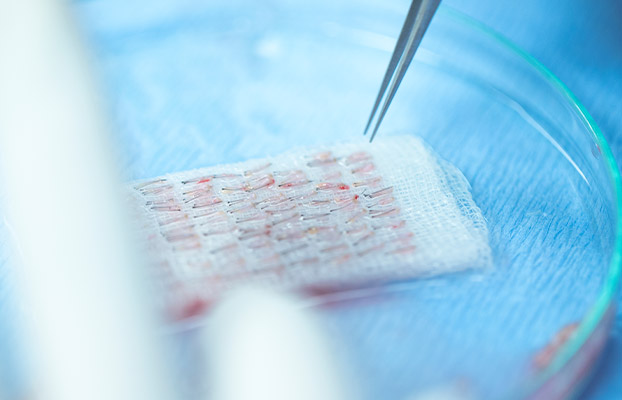Everything You Need To Know About Hair Transplant Grafts

Sommaire
Hair loss is perhaps one of the most inconvenient things to experience in life. Yet, over 50% of men and women experience it. After you try several alternative remedies to slow it down, hair transplant surgery in Turkey appears as the next go-to solution.
Everything in a hair transplant is dependent on grafts. Choosing the correct number of grafts for coverage, determining the capacity of donor areas for harvesting, and grafts’ logical distribution directly affect a hair transplant’s quality.
The exact meaning of grafts and their role in a hair transplant operation is essential information you need to know before a hair transplant operation.
What Exactly Are Hair Grafts
Every hair on a human body consists of two parts. The first part, the follicle or hair root, is responsible for the generation of hair, and the second part is the hair shaft or the hair itself. In hair transplantation surgery, you can often run into a term graft, and a hair graft refers to a single follicle or group of hair follicles.
The hair transplantation surgeon has to loosen a hair follicle group to transplant the hair. Once removed, it is moved to the transplant area. In most cases, surgeons choose the back of the patient’s head for the donor area. This is simply because human genetics renders the hairs at the back of the head impossible to fall off.
A graft can consist of a single hair root or hundreds of hair roots. The grafts are essential for hair transplantation because they allow surgeons to restore your hair’s natural look. The single follicle grafts are used to form the hairline, while the grafts with multiple follicles are used to cover the more prominent areas hit by hair loss.
Two Different Methods to Collect the Grafts
Surgical hair restoration has roots that date back to the 1930s. Nowadays, there are two distinctive methods surgeons use to collect the grafts:
- Follicular Unit Transplantation (FUT): this procedure involves removing the strip of hair. The strip of the hair is then divided into smaller grafts which are replanted in the balding area.
- Follicular Unit Extraction (FUE): FUE is a significantly less invasive procedure involving removing follicular units one by one with microneedles, so-called punches. Surgeons replant the removed follicular units in the area hit by hair loss. As a sub-method, DHI has a graft extraction procedure similar to FUE.
The Maximum Number of Grafts During a Hair Transplantation
You are probably wondering about the maximum number of grafts during hair transplantation. It depends on several, the main one being the method used to collect the grafts.
If a surgeon uses the FUT method, the piece of the scalp from the back of the patient’s head can be split into smaller fragments – grafts. The maximum number of grafts in this instance is approximately 2,000.
As you can see, the FUE method is much more sophisticated and less invasive. A surgeon can punch a couple of thousands of hair grafts. During hair transplantation, a surgeon can transplant a maximum of 4,000 grafts. However, the average number of grafts transplanted during the FUE procedure ranges from 1,500 to 3,000.
Hair Transplant Scars
Once a hair is removed from its follicle, the skin can’t produce the follicle. It simply means that hair transplant procedures leave hair transplant scars. Since we mentioned two unique methods to collect the grafts, you should know they differ regarding how much scar is left after the procedure.
Although a surgeon uses the finest needles and micro blades, the FUT method still leaves a visible scar in the donor area. The FUT hair transplant scars are not significant, but they become visible if the patients prefer to wear short hairstyles.
The FUE technique offers relatively better results in terms of hair transplant scars. Thanks to cutting-edge technologies and tools, surgeons can make punch grafts as small as 0.6-1mm in diameter when removing individual hairs. Patients who undergo an FUE hair transplant can end up with scars almost undetectable to the naked eye.
How Many Grafts Do You Need For Full Coverage?
Determining the exact number of grafts needed for full coverage requires extensive consultation with a hair transplant specialist. However, on average, 4000 to 6000 grafts would be enough to cover an entirely bald scalp.
Where Can I Get Hair Grafts From?
To determine where to get hair grafts, your hair transplant doctor should calculate the number of grafts needed to achieve a natural hairstyle and analyze the donor area behind your head. If it cannot offer enough grafts, beard and body donor areas can be used for harvesting follicles.
Are All Hair Grafts Effective?
Donor areas should be analyzed to ensure they provide healthy hair follicles for the hair transplant. If healthy grafts are extracted and handled carefully before implantation, their survival rate would be more than 90% so those hair grafts will be effective.
If you are considering a hair transplant procedure, you should consider doing it with Dr Emrah Cinik at Dr Cinik Hospital. He is an established hair transplant expert specializing in the FUE hair transplant method. Dr Emrah Cinik has helped thousands of patients restore their natural hair look with minimal to no hair transplant scars. Feel free to contact Dr Cinik Hospital today to get a free hair analysis.



